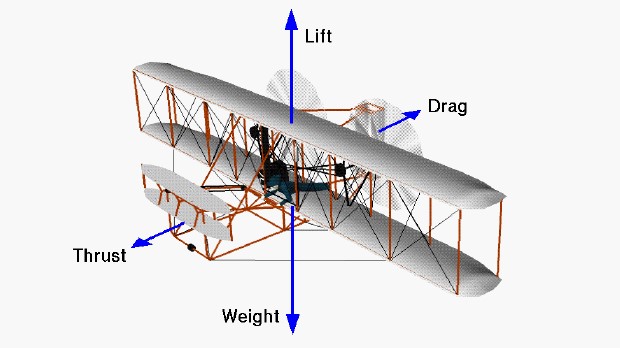Four Forces on the Flyer

A force may be thought of as a push or pull in a specific direction. This slide shows the forces that act on the Wright airplane in flight.
Weight
Weight is a force that is always directed toward the center of the earth. The magnitude of the force depends on the mass of all the airplane parts, plus the amount of fuel, plus the pilot. The weight is distributed throughout the airplane. But we can often think of it as collected and acting through a single point called the center of gravity. In flight, the airplane rotates about the center of gravity, but the direction of the weight force always remains toward the center of the earth. During a flight, the airplane’s weight constantly changes as the aircraft consumes fuel.
Lift
To make an airplane fly, we must generate a force to overcome the weight. This force is called the lift and is generated by the motion of the airplane through the air. Lift is an aerodynamic force (“aero” stands for the air, and “dynamic” denotes motion). Lift is directed perpendicular (at right angle) to the flight direction. As with weight, each part of the aircraft contributes to a single aircraft lift force. But most aircraft lift is generated by the wings. Aircraft lift acts through a single point called the center of pressure. The center of pressure is defined just like the center of gravity, but using the pressure distribution around the body instead of the weight distribution.
Drag
As the airplane moves through the air, there is another aerodynamic force present. The air resists the motion of the aircraft; this resistance force is called the drag of the airplane. Like lift, there are many factors that affect the magnitude of the drag force including:
- Shape of the airplane
- “Stickiness” of the air
- Speed of the aircraft
And like lift, we often collect all of the individual components’ drags and combine them into a single aircraft drag magnitude. The direction of the drag force is always opposed to the flight direction, and drag acts through the center of pressure.
Thrust
To overcome drag this airplane has a pair of propellers to generate a force called thrust. The propellers are turned by a small motor mounted on the top of the lower wing. It is often confusing to remember that aircraft thrust is a reaction to the air being pushed to the rear by the propellers. The air goes to the back, but the thrust pushes towards the front. Action <–> reaction is explained by Newton’s Third Law of Motion.
The motion of the airplane through the air depends on the relative strength and direction of the forces shown above. If the forces are balanced, the aircraft cruises at constant velocity. If the forces are unbalanced, the aircraft accelerates in the direction of the largest force.
You can view a short movie of “Orville and Wilbur Wright” explaining how the four forces of weight, lift, drag and thrust affected the flight of their aircraft.
